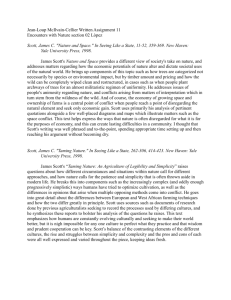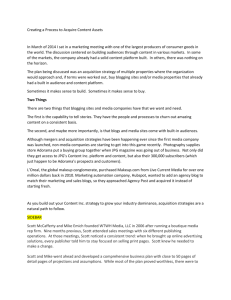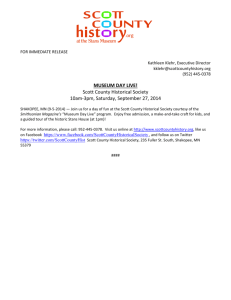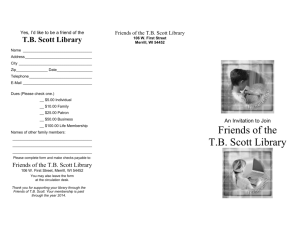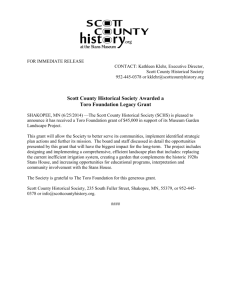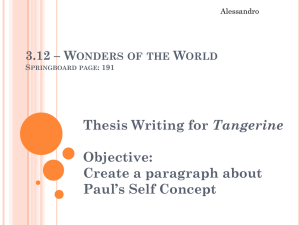F. Scott Fitzgerald
advertisement
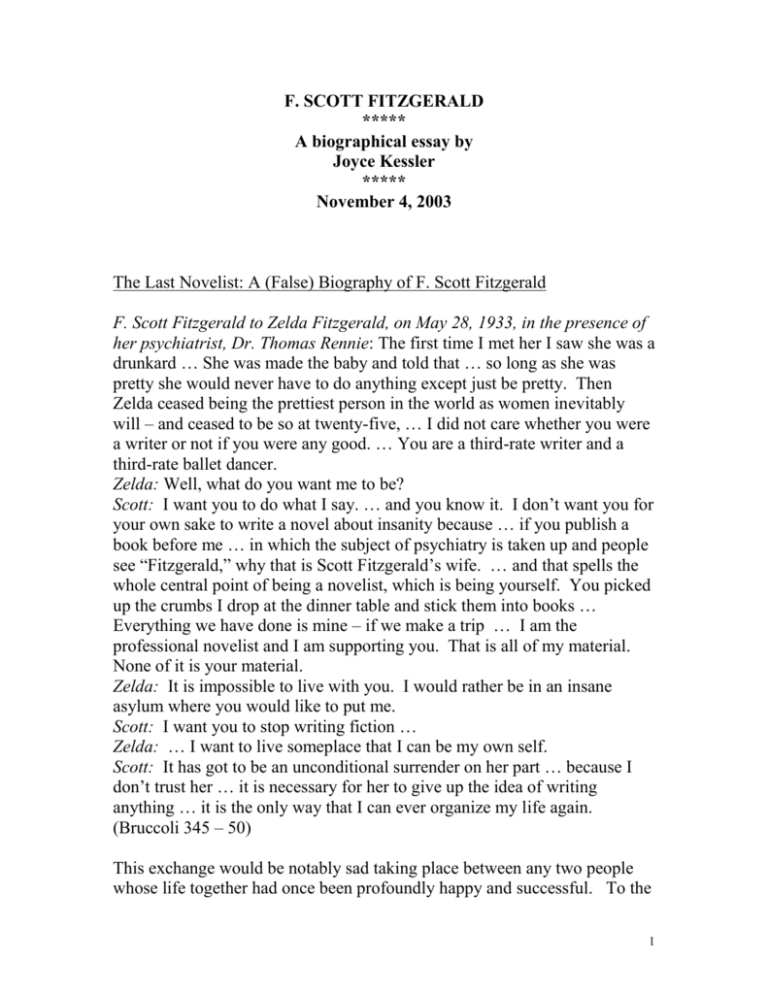
F. SCOTT FITZGERALD ***** A biographical essay by Joyce Kessler ***** November 4, 2003 The Last Novelist: A (False) Biography of F. Scott Fitzgerald F. Scott Fitzgerald to Zelda Fitzgerald, on May 28, 1933, in the presence of her psychiatrist, Dr. Thomas Rennie: The first time I met her I saw she was a drunkard … She was made the baby and told that … so long as she was pretty she would never have to do anything except just be pretty. Then Zelda ceased being the prettiest person in the world as women inevitably will – and ceased to be so at twenty-five, … I did not care whether you were a writer or not if you were any good. … You are a third-rate writer and a third-rate ballet dancer. Zelda: Well, what do you want me to be? Scott: I want you to do what I say. … and you know it. I don’t want you for your own sake to write a novel about insanity because … if you publish a book before me … in which the subject of psychiatry is taken up and people see “Fitzgerald,” why that is Scott Fitzgerald’s wife. … and that spells the whole central point of being a novelist, which is being yourself. You picked up the crumbs I drop at the dinner table and stick them into books … Everything we have done is mine – if we make a trip … I am the professional novelist and I am supporting you. That is all of my material. None of it is your material. Zelda: It is impossible to live with you. I would rather be in an insane asylum where you would like to put me. Scott: I want you to stop writing fiction … Zelda: … I want to live someplace that I can be my own self. Scott: It has got to be an unconditional surrender on her part … because I don’t trust her … it is necessary for her to give up the idea of writing anything … it is the only way that I can ever organize my life again. (Bruccoli 345 – 50) This exchange would be notably sad taking place between any two people whose life together had once been profoundly happy and successful. To the 1 extent that these snippets, transcribed from the original conversation, represent the steep decline of love and trust between an American couple so admired and even idealized during the early years of the 20th century, they express sentiments that are, certainly, “too deep for tears.” How could lives so full of promise become so blighted as were the lives of the Fitzgeralds a year before the publication of his last complete novel, Tender is the Night? What had been their hopes for one another, and how had they attained these or failed to do so? What had been Scott’s ambitions for this novel, and why was he so fierce in his wish to protect, even to possess as his “material ”alone, the life experience that he clearly shared with Zelda and on which this novel was in significant part based? Tender Is the Night began in the summer of 1925 as a very different novel. For a while, its working title was Our Type. The plot, as Scott planned it then, was to center on a young man from the United States named Francis Melarky who, while traveling in France with his controlling mother, murders her. During the years between his original conception of his fourth novel and its serialized appearance in Scribner’s Magazine between January and April of 1934, Scott wrote and published many short stories and essays and a few screen treatments, among which were The Rich Boy, All the Sad Young Men, How to Waste Material: A Note on My Generation, Lipstick (for United Artists), The Scandal Detectives, The Last of the Belles, The Original Follies Girls, First Blood, One Trip Abroad, Babylon Revisited, Emotional Bankruptcy, Red-Headed Woman (for Metro-Goldwyn-Mayer), Crazy Sunday, and Ring. In these same nine years, the Fitzgerald family restlessly crisscrossed the Atlantic, taking up brief residencies in Paris, the French Riviera, Hollywood, Delaware, again Paris, again Delaware, again Paris, again the Riviera, again Paris, then traveling to North Africa, to Switzerland (during Zelda’s first nervous breakdown), then to Alabama, and finally back to Baltimore (for Zelda’s second nervous breakdown). These were the years of Scott’s blossoming friendship with Ernest Hemingway, and of the Fitzgeralds’ madcap and increasingly drunken parties with the Hemingways and the Murphys. This was the period that Scott characterized in his 1926 Ledger as, “Futile, shameful useless … (254).” It was the life ground into which he placed the seeds of his fourth novel, the work that was to follow his most critically acclaimed work to that point, The Great Gatsby. Scott began to work in earnest on his project some seven years after his first start, in the summer of 1932, at his Baltimore home of “La Paix,” in which he and Zelda conducted the heartwrenching dispute quoted in the 2 beginning of this short (and if for no other reason, false) biography. Its new working title was The Drunkard’s Holiday, and at this stage of composition, he had eliminated Melarky and matricide, and also a subsequent plot and burned-out movie director protagonist by the name of Lew Kelly. His 1932 plan included Dick and Nicole Diver and the characters of Rosemary Hoyt and Tommy Barban. In his General Plan, he speaks of Diver as “a natural idealist, a spoiled priest, giving in … to the ideas of the haute Burgeoisie, and … losing his idealism, his talent and turning to drink and dissipation”. This character, a promising doctor, “falls in love with one of his patients who has a curious homicidal mania towards men … Aside from this she is the legendary promiscuous woman. … The difficulty of taking care of her is more than he has imagined and he goes more and more to pieces, …” Scott’s planning at this point indicated that Diver would rid himself of Nicole, while saving her from herself at the same time, by bringing her together with Barban. This, and his own “jealous agony” accomplished, he leaves her, “ … now being himself only a shell to which nothing matters but survival as long as possible with the old order” (Bruccoli 330-31). On these plans Scott worked diligently, while his marriage labored under the increasing strain of Zelda’s attempts to define herself as an artist in her own right. Her novel, Save Me the Waltz, was published in 1932; her play, Scandalabra, was produced in 1933, and her exhibit of paintings took place in 1934, just two weeks before the publication of Tender Is the Night. His Ledger for 1933 reads, “A strange year of Work + Drink. Increasingly unhappy. – Zelda up + down. 1st draft of novel complete Ominous!” (357). Where did Francis Scott Key Fitzgerald start, and how did he arrive at this strange and ominous point in his life? America’s “last novelist” was born on September 24, 1896, to Edward Fitzgerald and Mollie McQuillan Fitzgerald, in St. Paul, Minnesota. He was their third but only living child, and their only son, and so as a source of his parents’ hope, he perhaps bore more than his fair share of that burden generally carried by children. These tragic circumstances he was known to credit as the origins of his literary career: “Well, three months before I was born my mother lost her other two children and … though I don’t know how it worked exactly … I think I started then to be a writer.” His biographer, Matthew J. Bruccoli, observes that his name, too, suggests that his parents had high ambitions for their newborn son, whom they named after his famous second cousin, three times removed. At ten months, Scott uttered 3 his first word – “up” – and seems to have even then been in agreement with his parents about the proper direction for his life. Mrs. Fitzgerald perhaps understandably spoiled her baby boy, using inherited funds of her own to indulge him when his father’s middle class earnings fell short of the upper middle class advantages she wished to give him. Despite frequent relocations of the family necessitated by Edward Fitzgerald’s failing business career, Scott always strove for popularity in the various private and Catholic schools in which his parents enrolled him. He gave early evidence, too, in his dancing class at the Century Club in Buffalo, of becoming a ladies’ man. He was, of course, a highly intelligent boy, ambitious and self-possessed, but keenly moved by tales of his own origins and sensitive to his family’s concerns. His father’s stories of his own Southern ancestors fired his imagination and shaped his reading tastes throughout his boyhood. When his father lost his job as a salesman, Scott, even at eleven, betrayed a writer’s sensibilities in the depth of his understanding of the event’s significance. He later wrote about that day: “That morning he had gone out … a man full of strength, … He came home that evening, … a completely broken man. He had lost his essential drive, his immaculateness of purpose. He was a failure the rest of his days.” Although he was raised in the Catholic Church, its stories did not hold his attention as much as did the poems of Poe and Byron that his father read to him, and he was a loyal subscriber to St. Nicholas, a children’s magazine published during his childhood by Scribner’s Sons. At ten, he was recognized for writing a school essay on George Washington and Ignatius Loyola. Other writing projects at that time included a history of America and a detective story. His first published story, “The Mystery of the Raymond Mortgage,” appeared in the October 1909 issue of Now and Then, when he was thirteen. Despite his mother’s vision of her grown son as the successful businessman her husband had not managed to be, Scott was on his way to fulfilling his own writerly ambitions for himself; at about this time, he began to make record of his progress toward his goal of public recognition in his Thoughtbook of Francis Scott Key Fitzgerald, and a decade or so later, he began to record this trajectory in his Ledger. By the time he entered Princeton in 1913 (conditional on improvement in algebra, Latin, French, and physics), he had concluded his Newman high school career in Hackensack, New Jersey, with indifferent academic performance, but also with consistent improvement and 4 recognition as a writer of stories and plays. At Newman, he became involved with a mentor – Monsignor Cyril Sigourney Webster Fay – who was a probable model for the character of Monsignor Darcy in This Side of Paradise. Scott continued to strive through his writing for the public embrace during his college years: he wrote plays, poems, and short stories with increasing success. His play, Fie! Fie! Fi-Fi!, won the competition for the Triangle Club production of 1914-15. At the end of his Freshman year, he met John Peale Bishop, who was to be a close friend and a tremendous influence on him in the manner of his Paradise character, Thomas Park D’Invilliers. He also met Edmund Wilson, a member of The Nassau Literary Magazine, to which Fitzgerald and Bishop as well made contributions. In 1915, he also met Zelda’s forerunner, Ginevra King, a rich, beautiful, and popular society belle whom he pursued energetically for a year, until it became clear that she intended to marry someone wealthy. While his writing career trended upward and his romantic career seems to have stalled, his academic performance went in the opposite direction, and he was asked to repeat his Junior year. That year, 1917, would have been the year of his graduation if he had stayed with his class. As it was, it was the year that America entered WWI, and in November, Scott left Princeton to train for his commission as a second lieutenant in the infantry at Fort Leavenworth, Kansas. He was not particularly committed to his military duties, but in his spare time, he did produce the manuscript for “The Romantic Egoist,” the basis, in large part, for his first published novel. It was rejected by Scribners in 1918, but the rejection letter, written by Maxwell Perkins, praised its originality and invited a revised resubmission, which was accepted and published in 1920 as “This Side of Paradise”. It was while stationed at Camp Sheridan near Montgomery, Alabama, that Scott met Zelda Sayre in 1918. It took him two months to fall in love with her – he dated her friend, May Steiner, as well at first. Once committed to her in his heart, though, he spent the better part of the next year and a half convincing her to commit to him. Between September of 1918 and April of 1920, Scott pursued Zelda and his first novel with relentless energy, winning them both within a month of one another. During the remainder of his war commissions, he wrote love letters to Zelda, short stories, and drafts of the novel, traveling between his military posts and Montgomery. When he was discharged from duty in 1919 (the war having ended before his company was sent overseas), he settled into a similar routine, succeeding finally with his first commercial story sale: The Smart Set published “Babes in the 5 Woods” in the same year. Zelda capitulated early in 1920, and by that spring, the boy had both the career and the girl. Between their marriage and the publication of The Great Gatsby in 1924, the Fitzgeralds commenced to lead a glamorous life of travel, social prominence, fun, and professional success. In May of 1920, Scott went immediately to work on his next novel, The Beautiful and Damned, the first installments of which appeared in serial form at almost the same time as the birth of their only child, Scottie, in 1921. Metropolitan Magazine continued to run installments of the novel between between 1921 and ’22, and the complete novel was published in March of ’22. Scott wrote prolifically during those years, out of both ambition and financial necessity. The glitter of the Fitzgeralds’ life – the European trips, the brilliant parties, the endless changes of residency – was costly, and Scott’s astonishing ability to produce saleable short stories seemed a bottomless resource. And although they paid the bills (or perhaps because of that fact), Scott saw his short pieces as hack work, the production of which kept him away from his serious writing. Despite the fact that he had come to be regarded as a spokesman for his generation of Americans, he fretted that he set a bad business example, that he had squandered his earnings and was mismanaging his talents. Somewhere between 1923 and ’24, his reputation for being a member of the society party elite became a reputation for being an excessive drinker. The Fitzgerald’s marriage, founded in strong mutual attraction and attachment, blessed by a lovely child and by the appearance of material success, began to fall under its own weight. During the summer of 1924, F. Scott Fitzgerald’s life began to move in upward and downward directions at the same time. It was then, on the French Riviera, that the Fitzgeralds met Gerald and Sara Murphy, wealthy Americans with whom they would share an intense friendship not unlike the friendship between the Dick and Nicole Diver and Abe and Mary North. In July of that year, Zelda became romantically involved with the French naval aviator, Edouard Jozan. This event dealt the first terrible wound to the Fitzgeralds’ marriage. Although they soon reconciled, the couple began to lose their certainty about one another, and on that lost illusion, Scott founded the masterpiece he wrote during that summer and the following fall, The Great Gatsby. Despite its critical and popular acclaim, Scott believed the novel’s structure to be flawed, and noted in his Ledger that he saw the time of this favored novel’s creation as “The most miserable year since I was nineteen, full of terrible failure and acute miseries” (Bruccoli 204). 6 The ten years that followed in the life of Scott, who returned alone to Hollywood in 1932, were, as I have characterized them earlier in this modest chronology, increasingly bitter. In 1925, Scott formed a stimulating relationship with the young literary comer, Ernest Hemingway, but over that decade saw it deteriorate as the latter became ever more disappointed in Scott’s increased drinking and decreased literary output. The slowing of his literary productivity eventually strained his sustaining professional relationships, such as that with early supporter Maxwell Perkins and with Harold Ober, his long-suffering agent and friend. Ober and his wife became surrogate parents of Scottie in 1936, when she entered the Ethel Walker School in Connecticut. Due to Zelda’s nervous breakdowns and Scott’s distraction from work and growing alcoholism, the family was swamped with debt and misfortune. The Obers helped Scott, who never really abandoned her despite these difficulties, to provide Scottie with a steady family life during the years after Zelda’s hospitalization and Scott’s seemingly inevitable downward spiral. It was during this terrible decade of his life that Scott made his first trip to Hollywood, in 1927, at the request of a United Artists producer. His script project, Lipstick, was ultimately rejected, and he and Zelda quarreled over his attraction to a young screen star, Lois Moran. But Scott saw in Hollywood the prospect of new earnings from his writing, and did not relinquish that possibility, even though his gains on this first trip were not particularly distinguished. He did meet Irving Thalberg at M-G-M, who later furnished character material for his last novel. Between Zelda’s first and second breakdowns, to work on Red-Headed Woman for M-G-M. The screenplay was never used, but he was paid $6,000, money he badly needed. Even the publications of Tender, Taps at Reveille and The Crack-Up essays could not stop his fall into a pit of drinking and debt. In 1936, after Zelda entered Highland Hospital in Asheville, North Carolina, and his mother died in Washington, DC, Scott returned for a third try at the Hollywood gold ring. He landed a six-month contract at M-G-M for $1,000 a week and his contract was renewed the following year for $1,250 a week. If in the last four years of his life Scott did not exactly rush downhill, he kept a stately pace in that direction. In his first year there, he earned his only screen credit, for the script of Three Comrades. He also that year met his end-of-life companion, Sheila Graham. Six other scripts of his, including some work on Gone with the Wind, were not used. He was also writing fiction during these Hollywood years, plotting an historical novel of 7 medieval times, and working on short stories. Though he had been able to rely on his considerable skills in this latter form of literary creation, his alcoholism seemed finally to have eroded those skills; his last stories did not hold together, and his drinking pattern gave way to periodic benders. He was fired for drunkenness from his free-lance contract with United Artists in 1939. After two “dry-out” hospitalizations in New York, a final break with Harold Ober (stretched to the limit of tolerance by Scott’s professional irresponsibility), and some disastrous trial-vacations with Zelda, he attempted once more to redirect his life. Late in 1939, he sent a synopsis of a new novel to Perkins, asking for an advance. His working title was Stahr: A Romance, but elsewhere in the manuscript is a note for the title, The Love of the Last Tycoon A Western. His last novel, unfinished when he died, was about an overworked movie mogul with a sterling character whose health is destroyed by the industry, who almost loses the love of his life, and who is killed in a plane crash just as he begins to reverse the direction his life has taken. Scott’s main character was based, of course, on Irving Thalberg, the young man whose genius so impressed him on his first trip to Hollywood. Having been on the wagon for most of a year, Scott was working very hard on this novel in 1940, seeing his professional salvation in it, while continuing out of necessity to contract for screen work. None of the studios for whom he produced scripts accepted them, but he made appreciable headway on the novel, completing three-fourths of it. During this time, he had a “coronary episode,” and was treated with bed rest for alcoholic cardiomyopathy. Not quite a month later, on December 21st, still at work on the novel, he succumbed to occlusive coronary arteriosclerosis. In his Notebooks, he had ironically forecast this inevitability: “Then I was drunk for many years, and then I died.” He had been spending a quiet morning at home with Sheila Graham, who was studying the “College of One” assignment he had made as part of the curriculum of study he had invented in order for her to get the education she had missed to that point. He struggled up from his chair, grabbed for the fireplace mantel, and then fell to the ground, dead at fortyfour years of age. He was buried in Rockville Union Cemetery, in Maryland. After her death in a fire at Highland Hospital eight years later, Zelda was buried with her husband. Their bodies were reinterred at St. 8 Mary’s Church, in Rockville in 1975. Scottie died in 1986, and was buried with her parents. In the hopes of memorializing his dead friend and earning some money for his estate, Maxwell Perkins published the unfinished novel, with the title of The Last Tycoon, in 1941, as a special edition that included the text of The Great Gatsby and five short stories. The surviving works of F. Scott Fitzgerald, in all of their many editions, testify to the beauty of this artist’s vision of the world he inhabited. Again from his Notebooks, we have his simple statements: “ … I think it is the most beautiful history in the world. It is the history of me and my people. … It is the history of all aspiration – not just the American dream but the human dream …” (Bruccoli x). When we read his works, we become ennobled by the gorgeous power of this dream, communicated so masterfully to us by the little boy whose first word was “up.” 9
